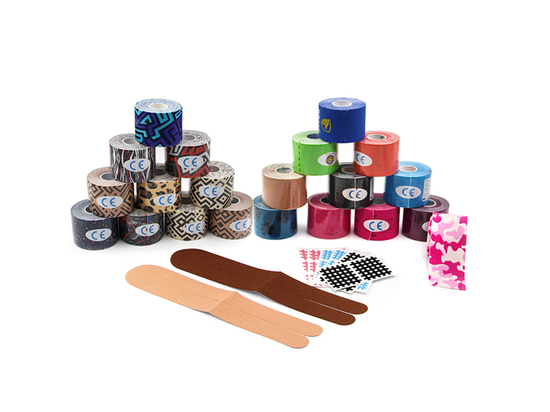
#Industry News
Comprehensive Guide for Kinesiology Tape: Types, shapes,Applications, and Benefits
Discover How Different Shapes and Uses of Kinesiology Tape Can Enhance Your Performance and Recovery
Kinesiology Tape: Types by Shape and Application Scenarios
Kinesiology tape comes in various shapes, each designed for specific applications and body areas. Understanding these shapes and their uses can help optimize the benefits of kinesiology taping. Here are the main types of kinesiology tape based on shape and their application scenarios:
1. I-Strip Tape
Shape: Long, straight strip.
Application Scenarios:
Muscle Support: Commonly used to support large muscle groups such as the quadriceps, hamstrings, and back muscles.
Joint Stabilization: Provides support to joints like the knee, elbow, and shoulder.
Tendon and Ligament Support: Used to reinforce tendons and ligaments, reducing the risk of injury.
2. Y-Strip Tape
Shape: Tape split at one end to form a "Y".
Application Scenarios:
Muscle Injuries: Ideal for treating muscle strains and sprains, as it can surround and support the muscle.
Lymphatic Drainage: Facilitates lymphatic drainage by covering a larger surface area.
Joint Pain: Commonly applied around joints to relieve pain and improve mobility.
3. X-Strip Tape
Shape: Tape with cuts forming an "X".
Application Scenarios:
Complex Joints: Used for complex joints like the shoulder or hip, providing multi-directional support.
Large Muscles: Supports large muscle areas by covering them from different angles.
Pain Relief: Reduces pain in multi-directional movements, providing comprehensive support.
4. Fan Strip Tape
Shape: Tape with multiple longitudinal cuts, resembling a fan.
Application Scenarios:
Swelling and Edema: Effective in reducing swelling by promoting lymphatic drainage.
Post-Surgery Recovery: Helps in managing post-surgical swelling and bruising.
Inflammation Control: Used to control inflammation in large areas like the thigh or calf.
5. Pre-Cut Shapes
Shape: Pre-cut into specific shapes like I-strips, Y-strips, and X-strips.
Application Scenarios:
Convenience: Ideal for quick application, especially in clinical settings or for self-application.
Specific Injuries: Tailored for specific injuries or body parts, ensuring correct application every time.
Sports Events: Useful for athletes who need rapid application during sports events.
6. Donut Strip Tape
Shape: Circular shape with a hole in the middle.
Application Scenarios:
Point Pain Relief: Provides relief for localized pain points, such as trigger points or small muscle knots.
Blister Prevention: Used to protect against blisters by reducing friction in areas like the heels or palms.
Pressure Relief: Helps to distribute pressure away from painful areas.
7. Web or Spider Tape
Shape: Tape cut into a web or spider pattern.
Application Scenarios:
Multi-Directional Support: Provides comprehensive support in multiple directions, ideal for complex muscle structures.
Enhanced Flexibility: Allows for greater flexibility and range of motion while still offering support.
Dynamic Movements: Useful for athletes engaged in dynamic sports like gymnastics or martial arts.
8. Cross Patch Tape
Shape: Small, grid-like patches.
Application Scenarios:
Trigger Points: Applied to trigger points for pain relief.
Small Injuries: Effective for small, localized injuries or areas of discomfort.
Acupuncture Points: Often used in conjunction with acupuncture or dry needling techniques.
9. Circular Tape
Shape: Circular pieces.
Application Scenarios:
Nipple Protection: Used by runners and athletes to prevent chafing of the nipples.
Small Wounds: Covers and protects small wounds or abrasions.
Blister Prevention: Protects areas prone to blisters, such as toes or fingers.
By understanding the different shapes of kinesiology tape and their specific applications, users can select the most suitable tape for their needs, ensuring optimal support and effectiveness in various scenarios.






